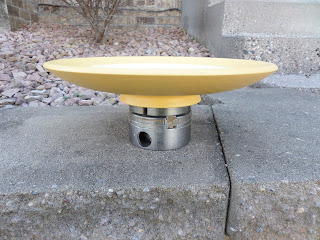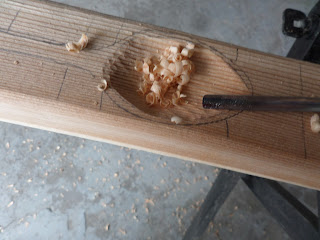Here is a project I've been thinking of doing for a while-doing some hand carving on the lathe.
Using a lathe for carving or painting or other non-turning types of work isn't new-many turners use the lathe to steady pieces of work while they apply some sort of surface adornment to their work. I'm going to use the lathe today to shape a carving blank for a small 3-D statue.
Discussion and Plans
I'm going to use a section of a red maple tree branch as a turning blank and turn it into a carving plank for a small statue called a jizo and here is a photo of what they look like:

In this photo you can see that the figure is basically a very simple one-it consists of a head section and a body section with some simple detail carved into the surface.
I'm going to use the lathe to accomplish two things-first, to turn the tree branch down into the basic head-body shape and second to use the lathe as a vice to hold the blank steady while I carve the surface.
Here are some photos of today's turning:
This is a photo of the branch that I plan to use. It's red maple, which is quite a common tree where I live, and it's one of my favorite turning woods. It holds detail well and I also like the color of the wood as it looks very nice with food on it. It also is carveable unlike harder species of maple:
I'm going to place it between centers on the lathe:
Then I began to turn it down to a cylinder. In the photo you can see a crack in the wood that I will avoid when I mark out the section that I intend to create for the statue:
Here I've marked off the sections for the head and body:
And I began to shape the body first as this is the simpler of the two forms:
In the next several photographs you can see the carving blank slowly taking shape. The head portion was the more difficult of the two shapes to form. It needed to be sized to be in proper proportion to the body (see the jizo photo above) and that took a lot of careful shaving the surface with a skew chisel:
After about 30 minutes of cutting this is the shape I've settled on. You can see that it's still attached to the lathe via the waste wood on the ends. When I'm completely finished carving the statue, I'll turn the lathe back on and turn off the waste ends. Hopefully I won't screw this up:
Now that I'm finished turning the blank, I've locked the lathe in place and drawn on some features with a pencil. I'm going to leave the tool rest in place and use it to rest my hand on while I'm cutting the surface:
And there we have it. I'll do a little carving and show you some photos with my next posting.
Stay tuned,
VW



















































